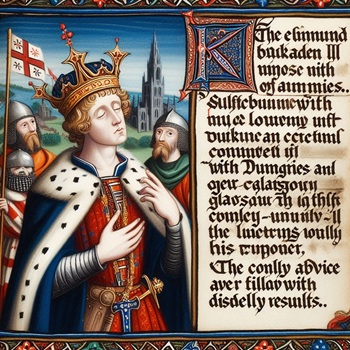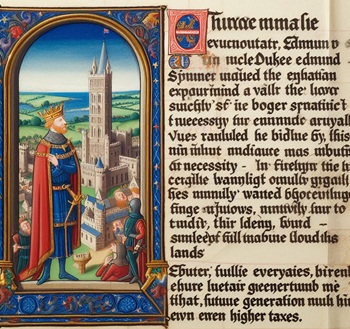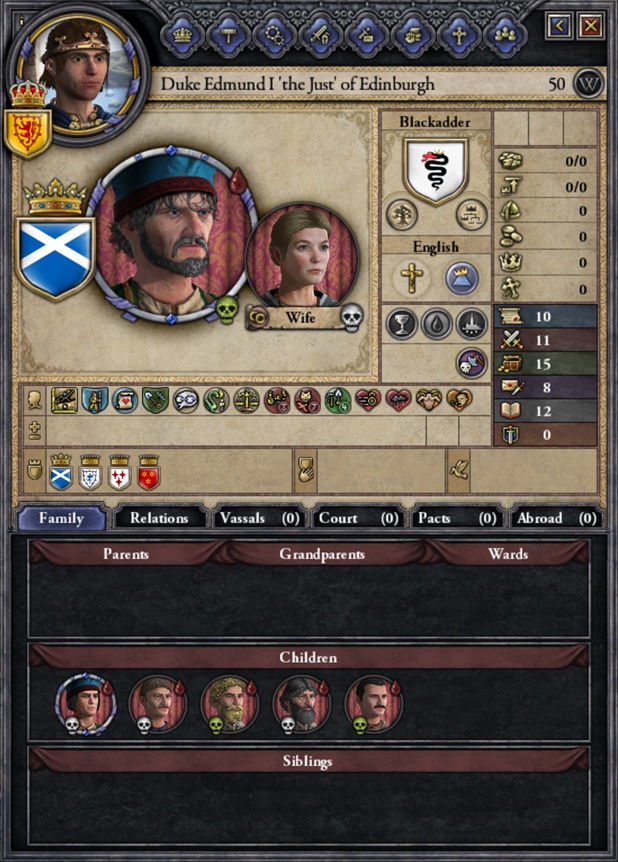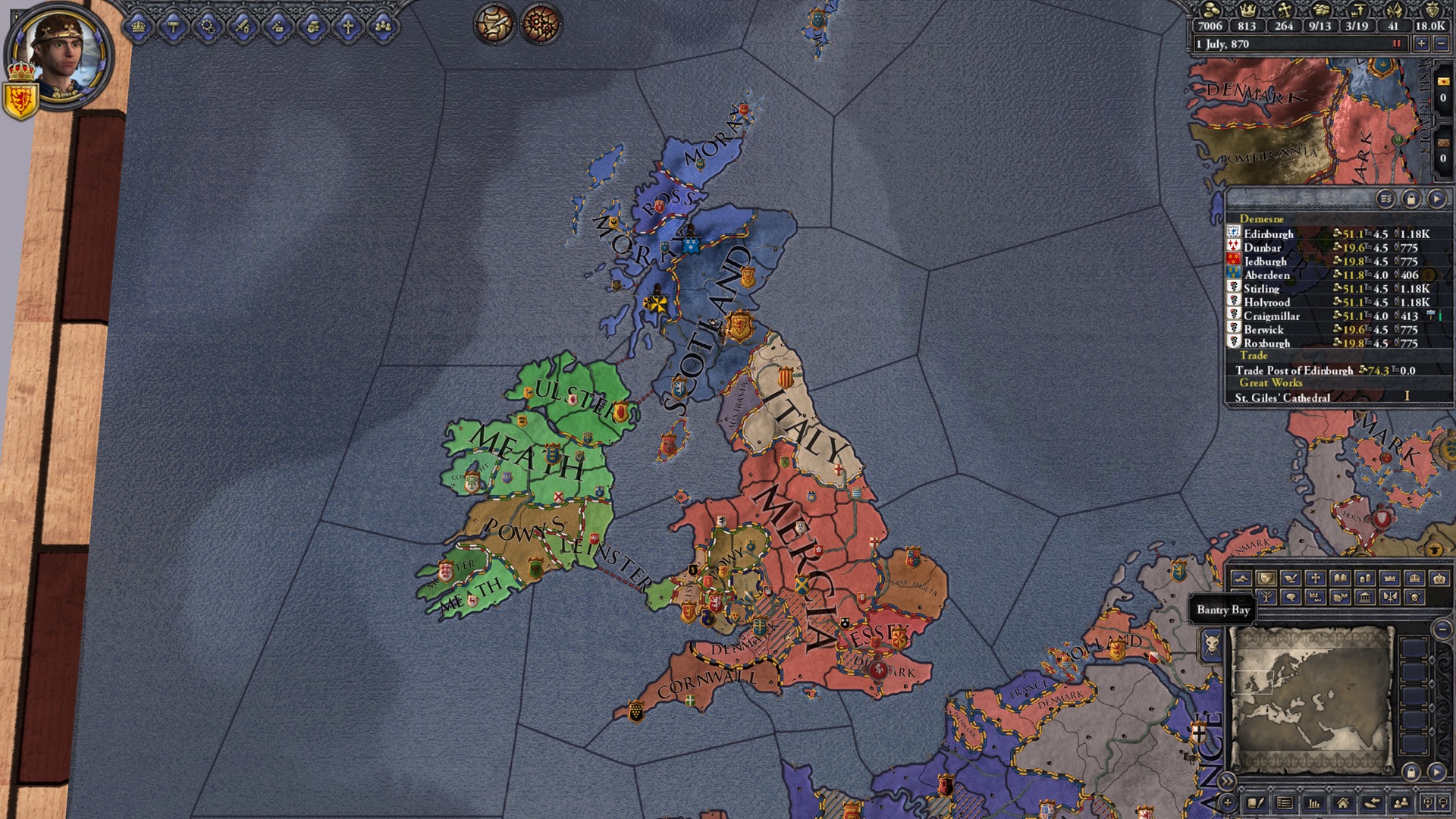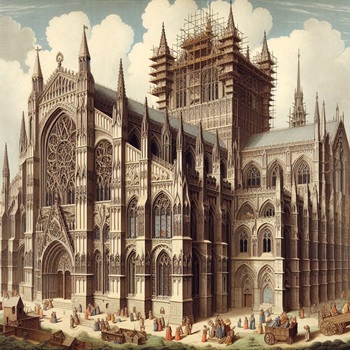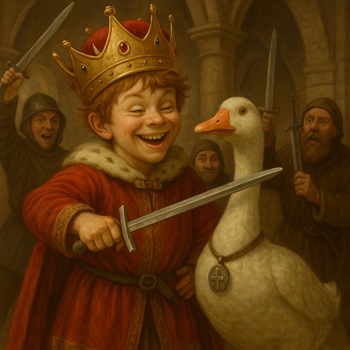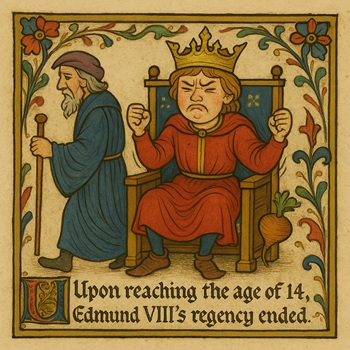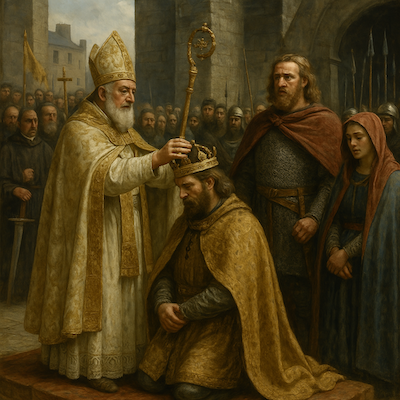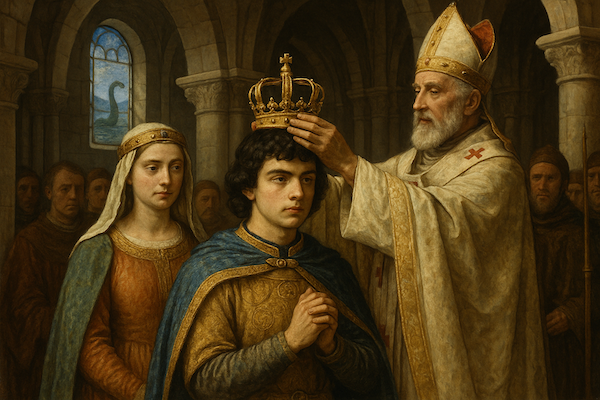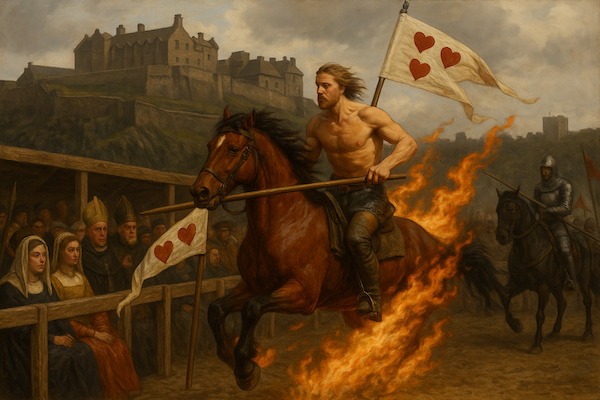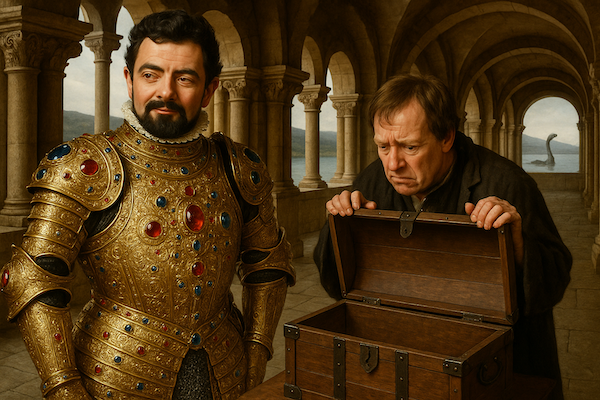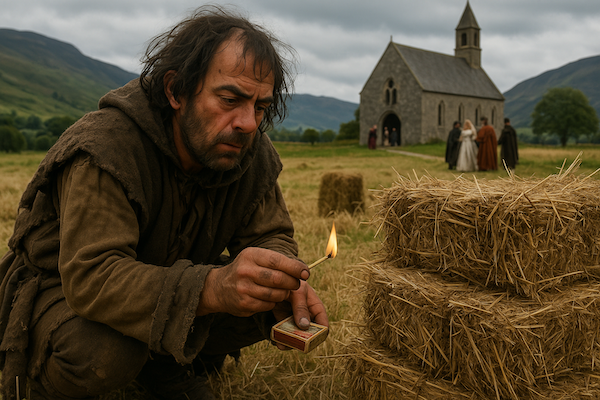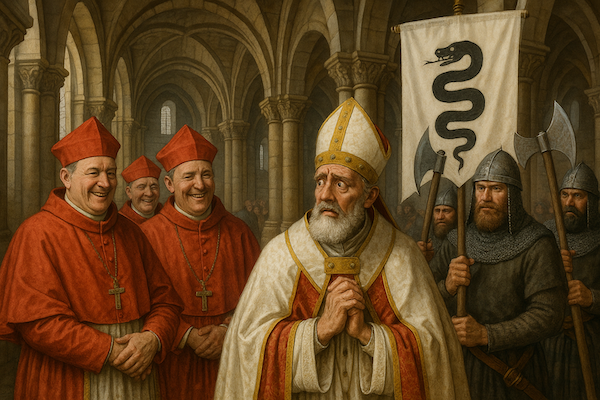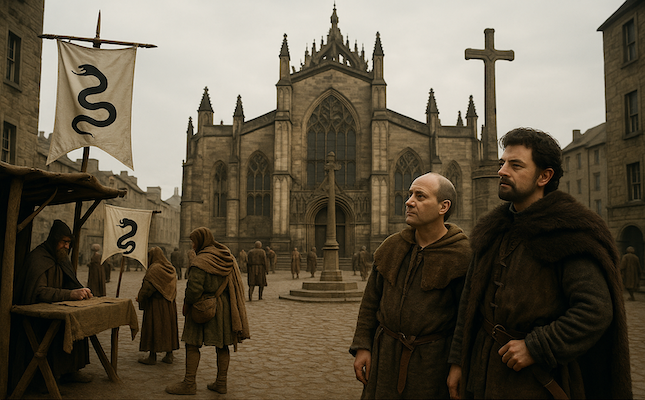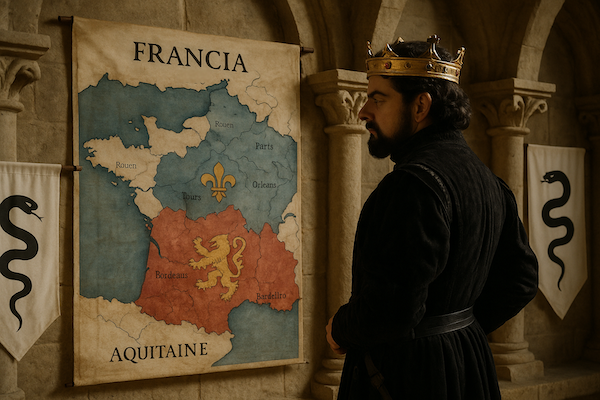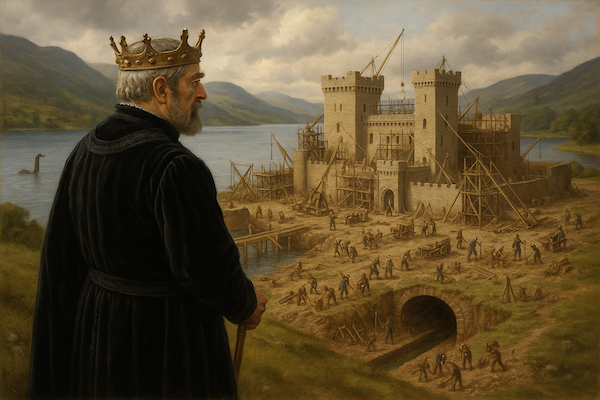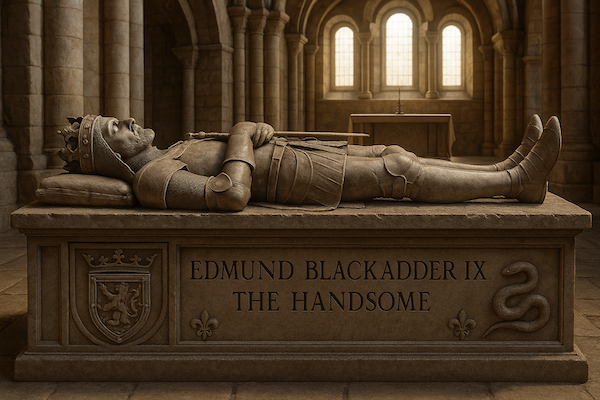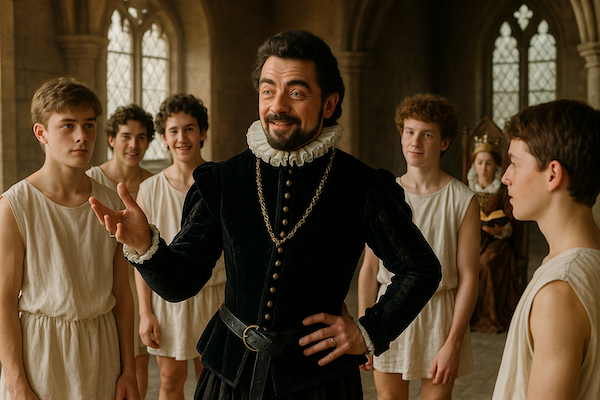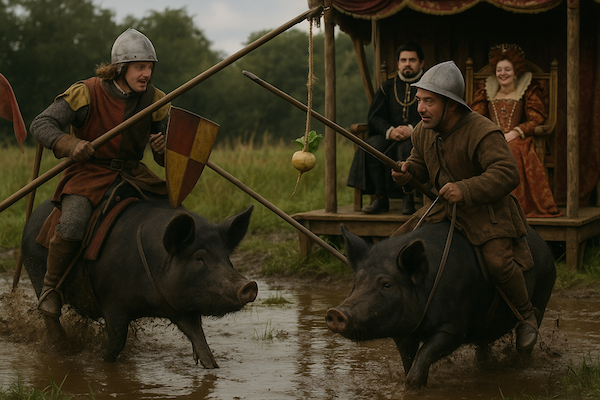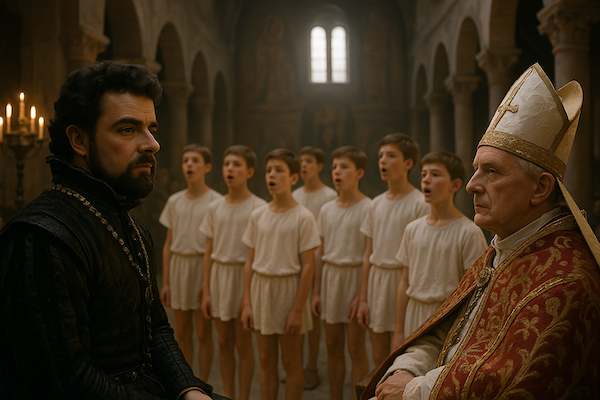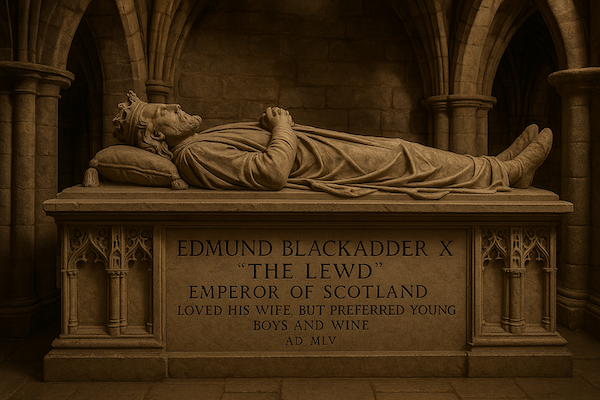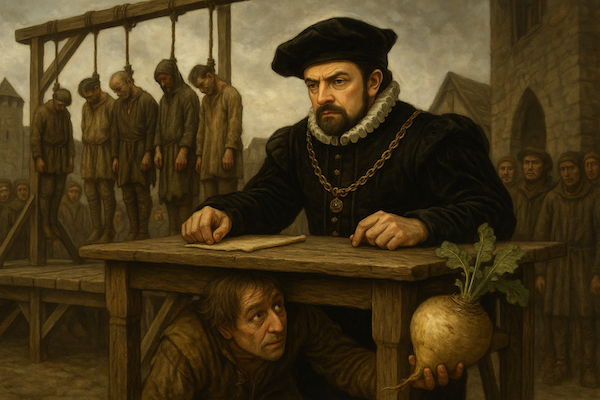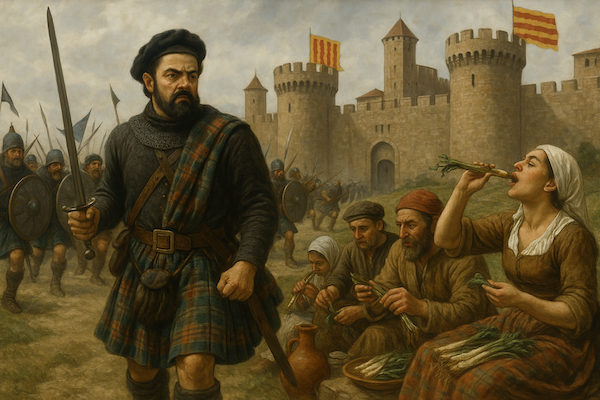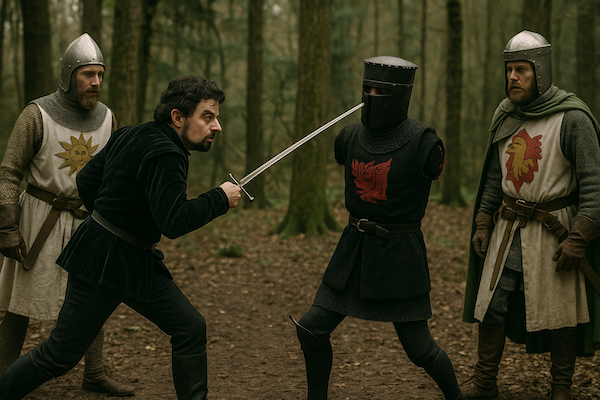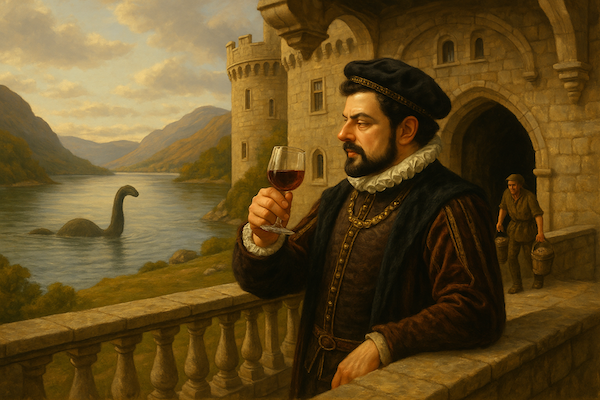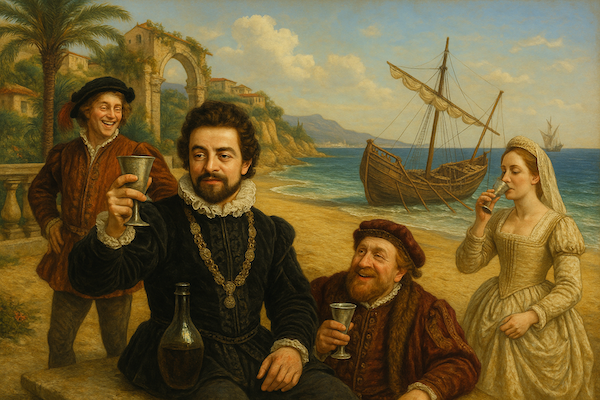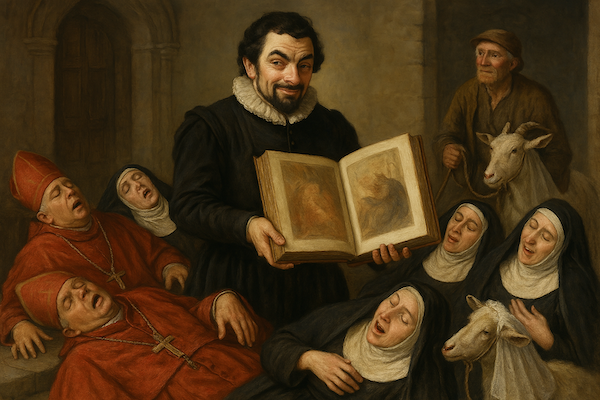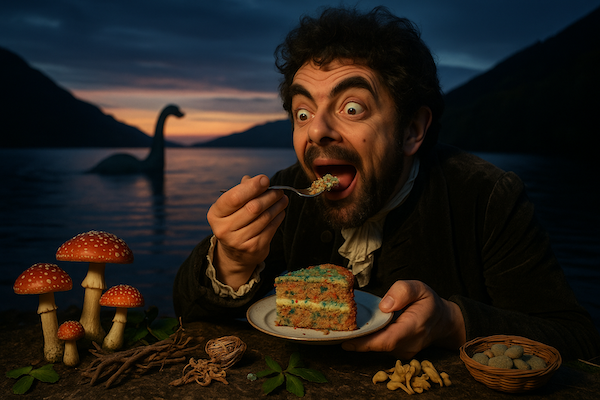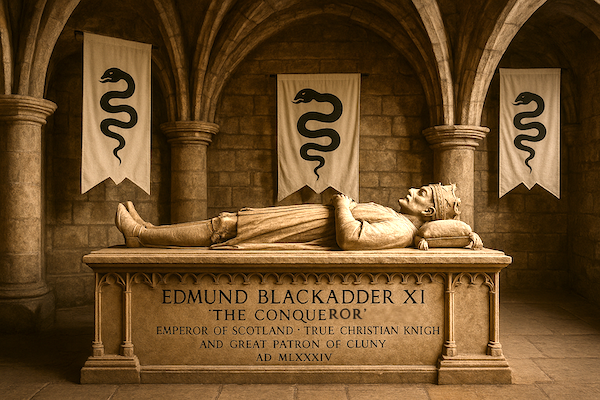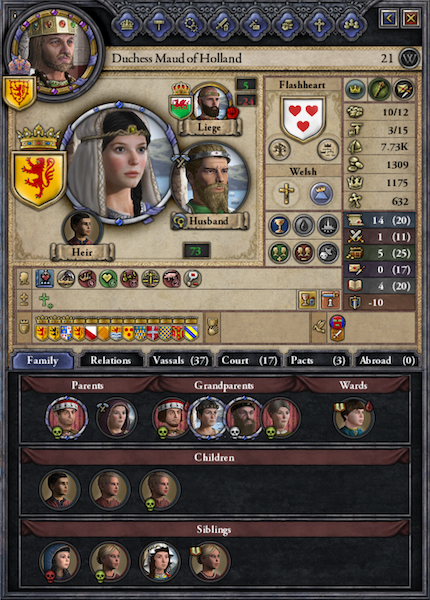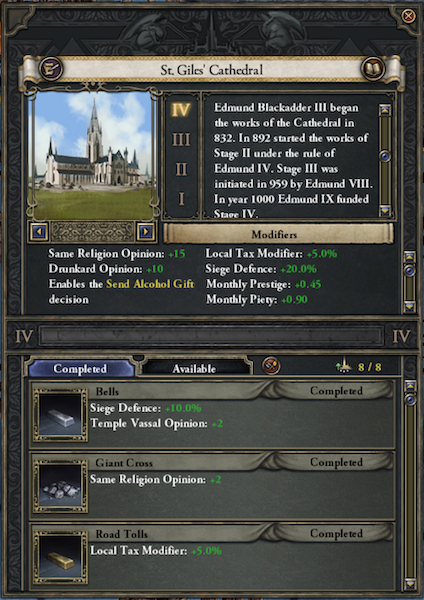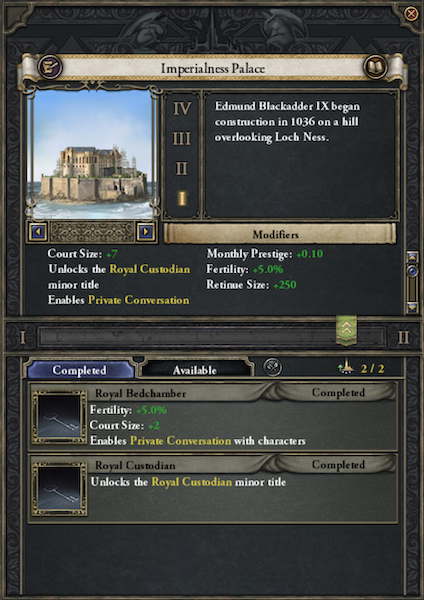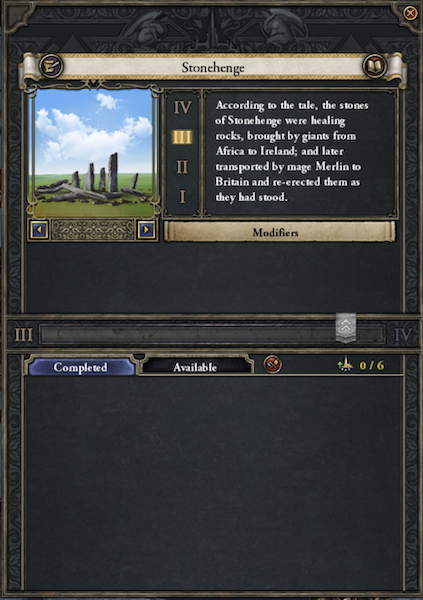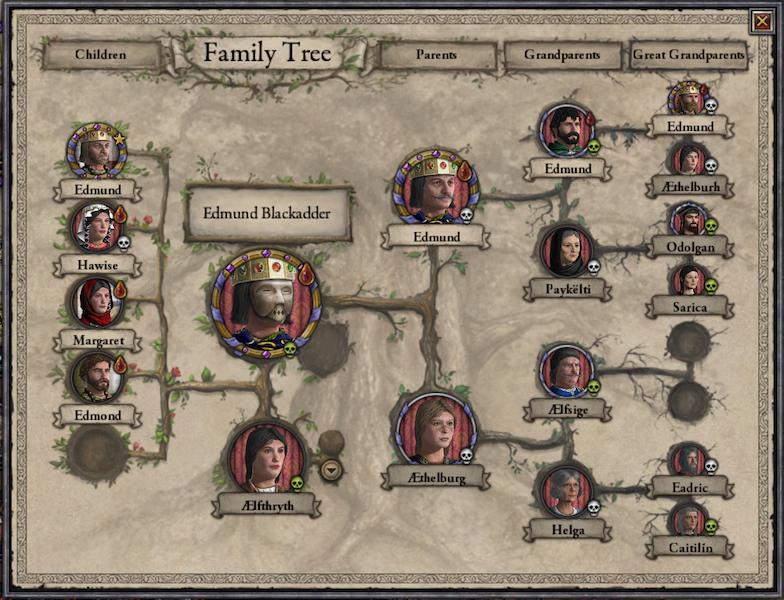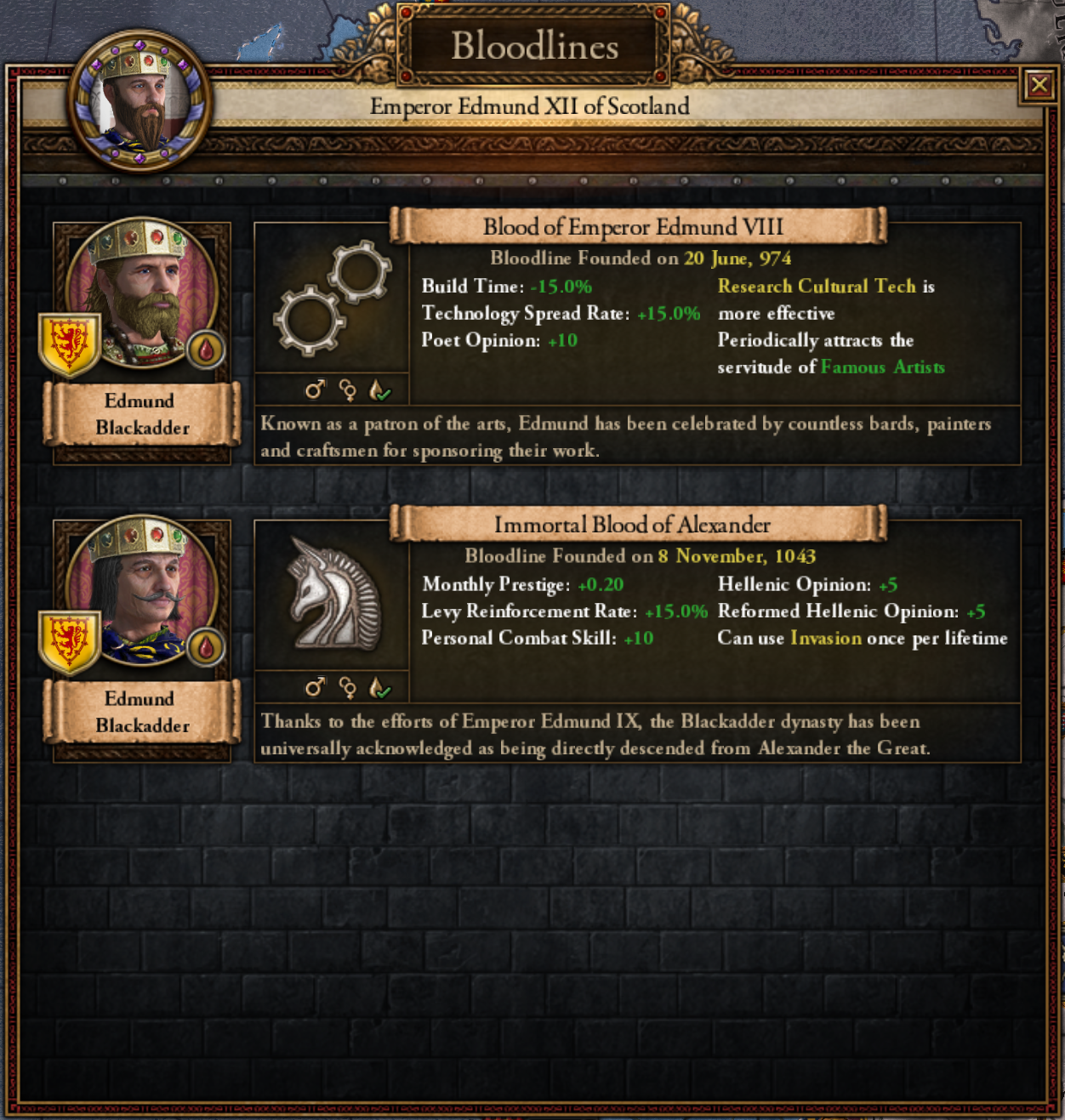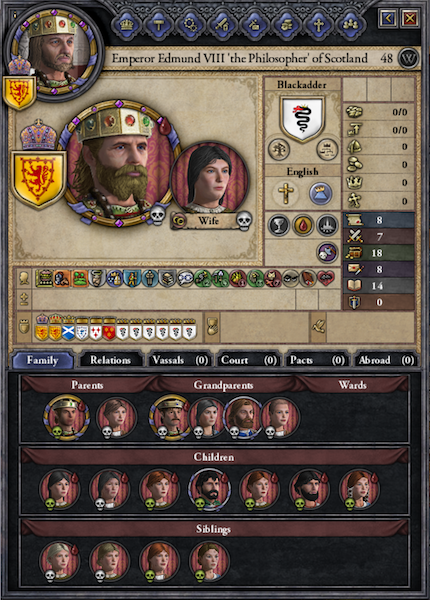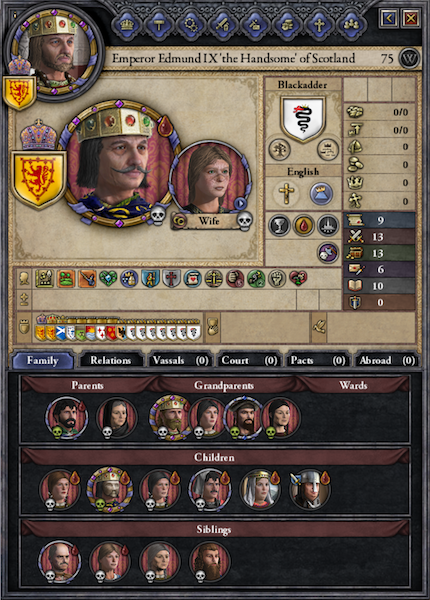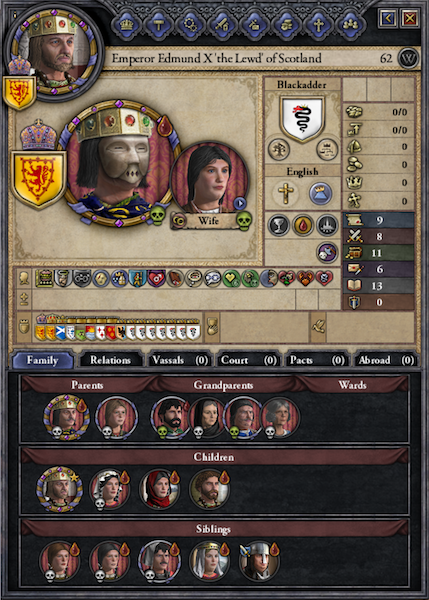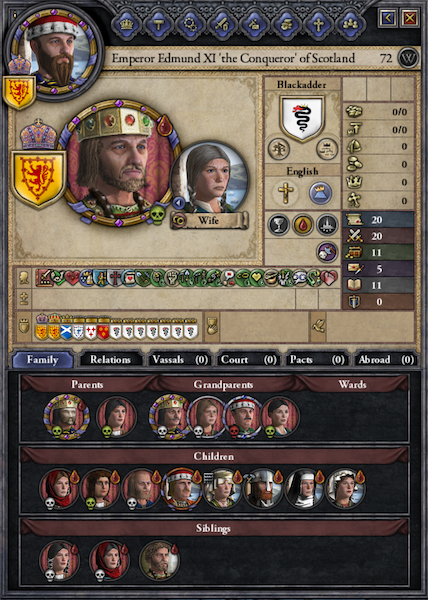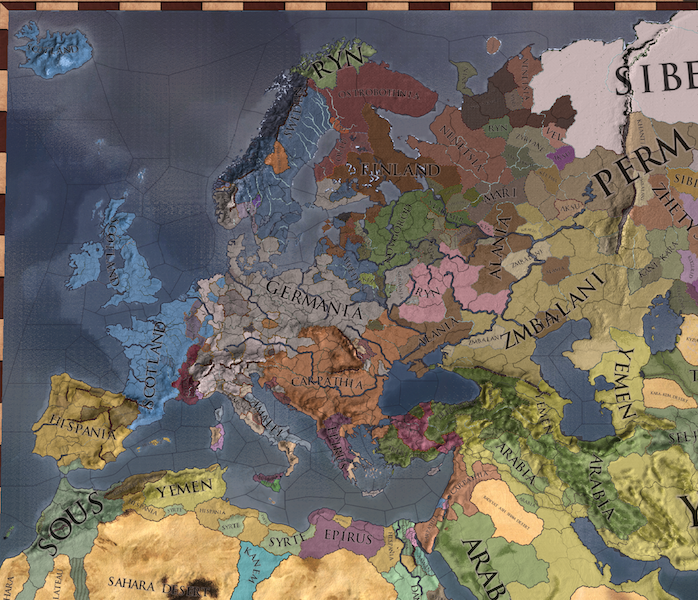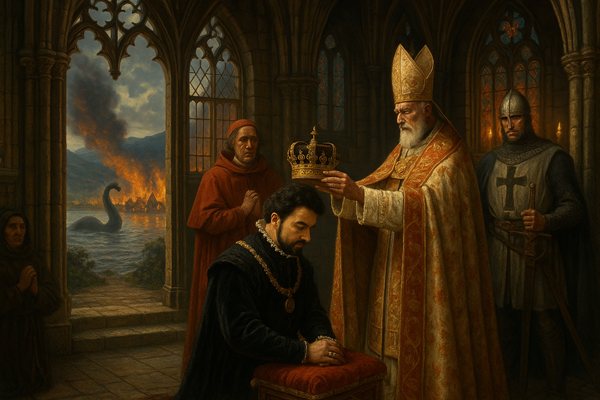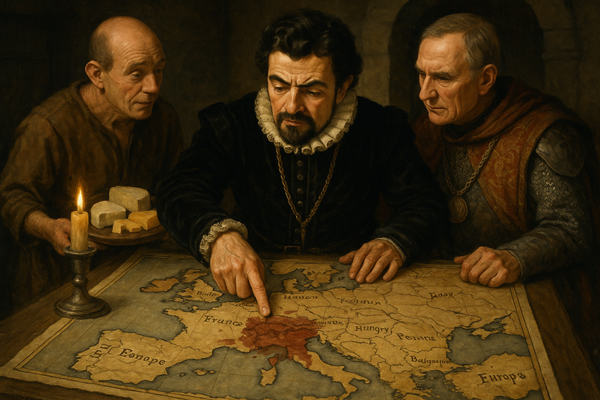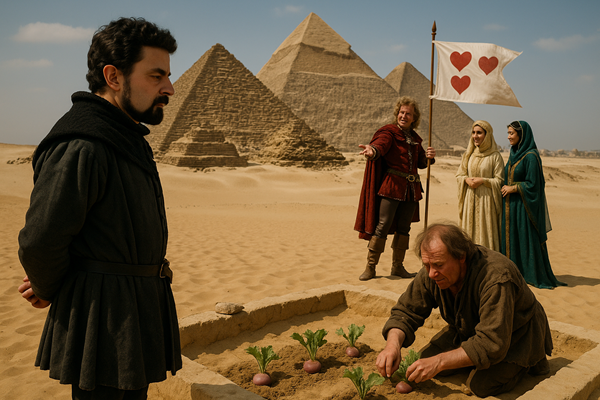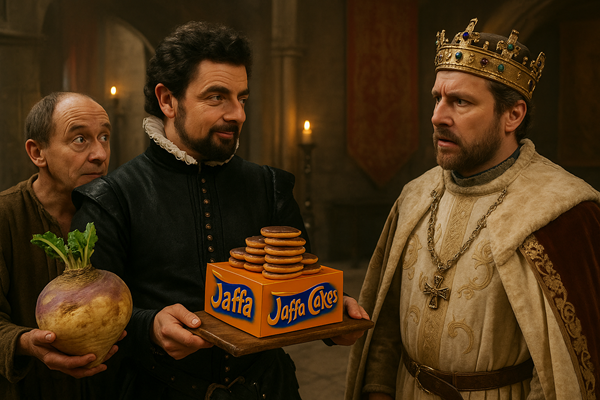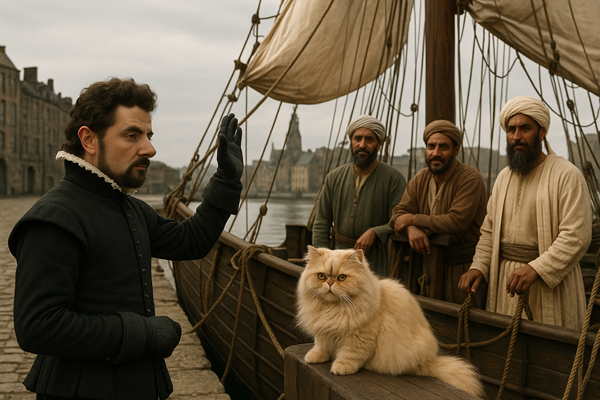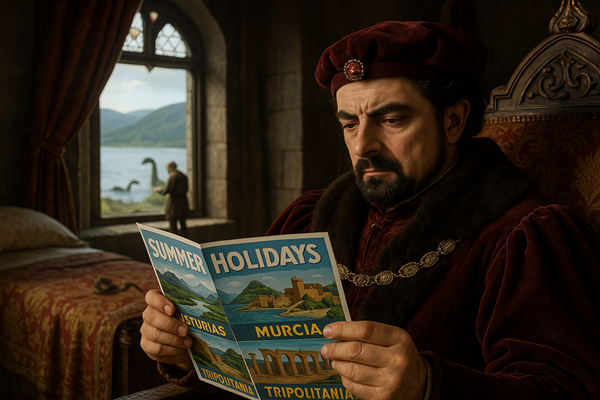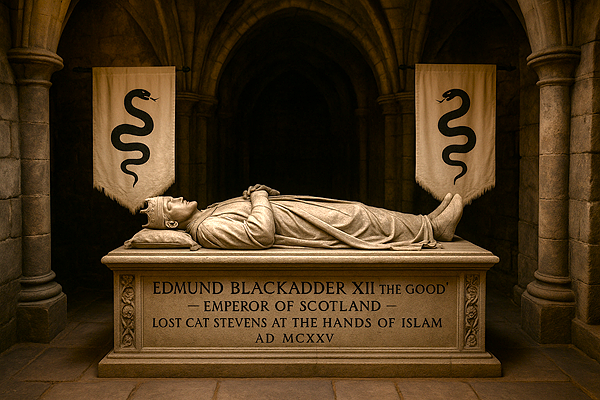CHAPTER I : LORD EDMUND BLACKADDER 'THE JUST' - FIRST DUKE OF EDINBURGH (769-803)
In this most fateful year of 769, the noble Edmund Blackadder, with guile most cunning and wit most sharp, did lay claim to the fair lands of Edinburgh and Jedburgh. Through trickery, treachery, and the occasional well-placed bribe, he secured his dominion and was proclaimed the first Duke of his line, thus founding the most scheming dynasty Scotland had yet seen.
Having secured his dominion, the cunning Edmund Blackadder did gather to his court men of wisdom - and some of questionable competence. He named as his councillors the ever-dim Lord Percy Percy, the boastful Lord Harry Flashheart, the dour Lord Kevin Darling, and the pious yet menacing Bishop Alan of Edinburgh.
Edmund Blackadder did appoint Bishop Alan of Edinburgh as Chancellor, entrusting him with diplomacy. With piety and menace, he ensured alliances - or, when needed, excommunications most inconvenient.
Lord Percy Percy, despite possessing the tactical mind of a turnip, was named Marshal of the realm. Charged with training the troops, he ensured they were well-drilled, though often in entirely the wrong direction.
Lord Harry Flashheart, with his boundless confidence and thunderous laughter, was appointed Steward of the realm. Tasked with collecting taxes, he did so with flair-often demanding payment in gold, admiration, or the kisses of fair maidens.
Lord Kevin Darling, ever dour and perpetually exasperated, was named Master of Spies. With great reluctance, he was dispatched to Constantinople to acquire secret knowledge, though many feared he would return only with a sunburn and endless complaints.
Bishop Hugh of Jedburgh, a man of solemn prayers and surprisingly creative curses, was appointed Court Chaplain. Tasked with safeguarding the faith of the courtiers, he spent equal time delivering sermons and exorcising their many, many sins.
Lord Cecil Melchett, a man of booming voice and baffling tactics, was promoted to Commander and placed in charge of the Edinburgh levies. With great enthusiasm and minimal strategy, he prepared the troops for glorious, if utterly misguided, victories.
Lord Baldrick Baldrick, a man of questionable hygiene and even more questionable intellect, was promoted to Commander and placed in charge of the Jedburgh levies. His plans, often described as cunning, mostly by himself, ensured that confusion remained the army's most reliable weapon.
Duke Edmund Blackadder did graciously authorize a weekly market in Edinburgh, allowing peasants, herdsmen and artisans to sell their wares. Naturally, a generous portion of the profits found its way into the Duke's coffers, proving that commerce, like war, was best waged with cunning and a well-placed tax.
The most shrewd and opportunistic Edmund Blackadder did take to wife the noble Lady Lantsuinda Adalberts, daughter of Count Odacre of Valais. This union, forged more from political convenience than affection, did secure alliances most advantageous - while some whispered that the bride possessed both the charm and warmth of a frozen codpiece.
In the waning days of 769, Duke Edmund Blackadder undertook a pilgrimage to Ireland to visit the tomb of Saint Patrick, though some noted that he merely sought a change of scenery. Along the way, he encountered strange folks, learned dubious skills, and, most importantly, perfected the art of avoiding tavern bills.
In the turbulent year of 769, amidst much bickering between local lords, Edmund Blackadder found himself accidentally involved in a skirmish near Edinburgh. Riding out for a leisurely hunt, or, as some claimed, to inspect hygiene at brothels, he stumbled upon two warring clans. Mistaking his arrival for royal intervention, both sides hastily agreed to a truce. Ever the opportunist, Blackadder took full credit for 'negotiating peace' promptly taxing both clans for the service.
On the 11th day of November in the Year of Our Lord 770, Lady Lantsuinda did give birth to a son, named - by great effort of imagination - Edmund II. The child, red-faced and already scowling, was declared the future heir. Courtiers agreed he had his father's sharp wit and, regrettably, his mother's terrifying glare.
In the grim year of 771, a most unwelcome guest arrived in the counties of Edinburgh and Jedburgh: Slow fever. This most inconsiderate plague claimed a fifth of the population, much to the dismay of grieving families and, more importantly, tax collectors. Ever pragmatic, Duke Edmund Blackadder decreed mourning should be swift and business swiftly resumed - especially the paying of dues.
In the Year of Our Lord 772, Duke Edmund Blackadder, ever fond of avoiding costly battles, especially those he might lose, signed a pact of non-aggression with Earl Ffernfael Morgannwg of Gwent. The treaty was sealed with much pomp, feasting, and suspiciously insincere smiles - both men privately confident they would outscheme the other before long.
On the fourth year of his reign, Edmund Blackadder embarked on what was meant to be a grand inspection of his realm but instead took an unexpected turn toward aquatic adventure. While crossing a river near Jedburgh, his horse, perhaps as cunning as its rider, decided midstream was an excellent place to stop. The Duke, unamused and increasingly damp, was forced to swim to shore, dignity sinking faster than his boots.
On the 7th day of December in the Year of Our Lord 774, Lady Lantsuinda once again fulfilled her dynastic duty, giving birth to a second son, named - through sheer display of imagination - Edmond. The child was declared healthy, loud, and already frowning, proving beyond doubt that he was a true Blackadder.
By the grace of fate, in the year 775, the dreaded Slow fever plague at last loosened its grip on the lands of Edinburgh and Jedburgh. Survivors rejoiced, priests gave thanks, and tax collectors dusted off their ledgers with renewed enthusiasm. Ever pragmatic, Duke Edmund Blackadder declared the crisis over and immediately raised tariffs - after all, someone had to pay for all those funerals.
In the Year of Our Lord 776, the shepherds of Edinburgh, having enjoyed a particularly prosperous season, decided to form a Guild to protect their interests. Duke Edmund Blackadder, ever alert to new opportunities - especially those involving other people's money - graciously approved their charter and promptly introduced a special Guild Tax on the new activity.
Duke Edmund Blackadder, in a decision both bold and deeply misguided, appointed Lord Harry Flashheart as Tutor of the Court, responsible for the education of noble children. Lessons quickly devolved into tales of dashing exploits, swordplay practice and enthusiastic shouting - ensuring a generation of pupils well-versed in bravado but utterly clueless in arithmetic.
In the quiet and peaceful year of 778, Duke Edmund Blackadder, ever the lover of pomp and circumstance, commissioned a Crown, Scepter, and Ceremonial Sword from the finest goldsmith in Edinburgh. The resulting set, grand in appearance but somewhat prone to tarnish, was promptly used in all manner of ceremonial occasions - mostly for the purposes of impressing guests and avoiding actual work.
Pope Stephanus III, leader of all Catholic faithful, died of Consumption on March 25th, 779. After a few days of tense confinement in Rome, the College of Cardinals finally elected the new Holy Father. Thus, Pope Nicolaus ascended to the papal throne as Supreme Pontiff of the Universal Church, Vicar of Christ, Bishop of Rome, Primate of Italy, Archpriest of the Holy Roman Church, Sovereign of the Vatican City and Servant of the Servants of God.
Duke Edmund Blackadder's hunting trip turned disastrous when Baldrick mistook his prized falcon for a chicken and tried to roast it. The enraged bird escaped, attacking the party and sending nobles fleeing. Blackadder returned to Edinburgh scratched, furious, and increasingly convinced Baldrick's 'cunning plans' were secret assassination attempts.
In the Year of Our Lord 780, Duke Edmund Blackadder of Edinburgh led a most successful raid into Cumberland. With sword in hand and a smirk on his face, he pillaged villages and castles alike, leaving behind a trail of confusion, stolen silver and, occasionally, a bewildered sheep or two. The Duke returned victorious, though, as usual, his most treasured spoils were the excessive taxes he imposed on his own lands to fund the venture.
In the wake of his successful (and thoroughly self-serving) campaign in Cumberland, Edmund Blackadder, ever one to enjoy a bit of irony, was bestowed with the title 'the Just' by his subjects. This, of course, had little to do with fairness or virtue, but rather with his impeccable ability to justify any action - no matter how ruthless or absurd - using the most convoluted logic. The peasants, secretly laughing, nodded in agreement, grateful that 'the Just' didn't yet decide to raise taxes for breathing.
In the rainy and cold year of 781, Duke Edmund Blackadder, with his usual flair for expansion, set his sights on the County of Bernicia. Once again, he led a raid of unparalleled efficiency - pillaging villages, looting castles, and generally leaving chaos in his wake. The locals, unable to stop him, could only lament the the Duke's ability to justify his actions and keep all the loot for himself.
Encouraged by the resounding success of his previous raids, Duke Edmund Blackadder, ever the ambitious strategist, set his sights on the County of Dunbar in the Year of Our Lord 782. This time, however, his intent was not mere plunder, but full annexation. With cunning as sharp as his tongue, he devised a plan to take Dunbar under his control - although his current ruler, King Æthelred of Northumberland did not share Blackadder's point of view.
Duke Edmund Blackadder, with an army of a thousand men - most of whom were likely as competent with a sword as Lord Percy Percy was with a map - laid siege to Dunbar. The campaign, which stretched on for an entire year, was a test of both patience and questionable military tactics. Despite the unrelenting siege, Edmund's forces finally claimed victory, securing Dunbar for his growing realm. The Duke, of course, took full credit, though he spent more time in the tavern than on the battlefield.
Once Dunbar had been annexed, Duke Edmund Blackadder, ever the master of rewarding loyalty, appointed his distant-cousin Lord Henry MacAdder as Commander. Lord MacAdder, a man of few words and even fewer successful strategies, was tasked with maintaining order in Dunbar - though it was widely suspected that his greatest contribution would be ensuring the local taverns stayed well-stocked and his soldiers well-distracted.
In the summer of the year 783, Duke Edmund Blackadder received troubling news: Lord Kevin Darling, ever the master of subtlety, had been discovered spying in Constantinople and was now an honored guest (or rather, prisoner) of the Basileus. With little hope of his return, Gregory Percy, son of Lord Percy, was appointed as the new Spymaster, ensuring that, if nothing else, Byzantine secrets would now be thoroughly confused rather than actually uncovered.
On the 11th day of August in the Year of Our Lord 784, Lady Lantsuinda once again fulfilled her noble duty and gave birth to a third son, Edward. Courtiers politely declared the child strong and healthy, though some noted with concern that, given his father's lineage, he was likely to grow up either dangerously ambitious or deeply sarcastic; if not both.
By the grace of fate, in 784, Duke Edmund Blackadder set sail on what was meant to be a routine diplomatic mission, only for his ship to be blown wildly off course. After an undignified shipwreck, a misunderstanding involving a chieftain's daughter, and a duel with an enraged fisherman over the price of herring, Blackadder inadvertently secured a lucrative trade route between Edinburgh and Romsdal in Norway - thus proving that fortune sometimes favors the deeply inconvenienced.
As the year 785 unfolded, Duke Edmund Blackadder commissioned a grand establishment in Edinburgh - only to discover too late that his request for a brothel had been misinterpreted as a hospital. Seeing the joy of his subjects, he cunningly accepted the confusion and created the new Healthcare Tax.
With the turning of the year 785, young Edmund Blackadder II reached the noble age of 14 and was promptly granted the titles of Regent, Commander and Master of the Horse of Edinburgh. Whether this was due to his wisdom or simply his father's desire to offload responsibilities remains unclear.
As the year 785 drew to a close, Duke Edmund Blackadder proudly published THE FEUDAL REALM, a treatise on diplomacy and good governance. Lauded for its wisdom, the book was, in fact, a stolen manuscript from none other than Charlemagne himself. Thanks to some careful editing - mostly replacing 'Empire' with 'Duchy' and 'Charlemagne' with 'Blackadder' - no soul would ever question its true authorship.
Whilst chasing a particularly stubborn chicken, a peasant tripped over a peculiar rock near Jedburgh. Upon closer inspection, the rock turned out to be the protruding tip of a large gold vein. Duke Edmund, demonstrating his signature cunning, declared the land his own, imposing generous mining tariffs - generous for himself, that is.
On the 11th of July, 786, Lady Lantsuinda gave birth to Edwyn Blackadder, the Duke's fourth son. Though no one expected him to surpass his older brothers in ambition or charm, the newborn was promptly declared healthy and sure to inherit the family's knack for trouble. The Duke, ever pragmatic, began preparing his youngest son for a lifetime of slightly less challenging duties.
In the year 787, in a feat that defied all logic and reason, Duke Edmund Blackadder, without any clear explanation, predicted a meteor shower over Edinburgh. When the celestial display occurred exactly as he had foretold, nobles and scholars alike were left astounded. Naturally, Blackadder took full credit, claiming his uncanny foresight was yet another example of his superior cunning and intellect - though some whispered it was merely blind luck, wrapped in an overly grandiose proclamation.
On the 11th of January, 788, Lady Lantsuinda gave birth to Edgar, the Duke's fifth son. As customary, the newborn was promptly examined, declared fit, and handed over to the ever-busy servants. The Duke, ever practical, saw the new arrival as another future tax-paying subject, and, of course, another potential heir to his ever-expanding empire of mischief.
In the very glorious year of 788, Duke Edmund Blackadder, ever the opportunist, once again set his sights on the neighboring lands of Cumberland and Bernicia. His raid was, as always, a resounding success, returning with a healthy haul of gold, resources, and, of course, an inflated sense of fame.
During the 789 raid on Cumberland, Duke Edmund Blackadder led an attack on a wealthy village, while Baldrick, carrying the Duke's banner, tripped over a cow and planted it in a pile of manure. The Duke, ever quick-witted, declared the manure a 'cunning strategic advantage' - though privately wondered if it was time for a new banner-bearer.
Pope Nicolaus, leader of all Catholic faithful, died a natural death on July 8th, 790. After a few days of tense confinement in Rome, the College of Cardinals finally elected the new Holy Father. Thus, Pope Gregorius IV ascended to the papal throne as Supreme Pontiff of the Universal Church, Vicar of Christ, Bishop of Rome, Primate of Italy, Archpriest of the Holy Roman Church, Sovereign of the Vatican City and Servant of the Servants of God.
In the twenty-third year of his reign, Duke Edmund Blackadder, ever the master of bureaucracy, sanctioned the Municipal Charter for Edinburgh, granting the city official status. This new title allowed him to impose even more taxes and levies on the populace, much to their delight - or rather, their resigned grumbling. Blackadder, of course, hailed it as a triumph of governance and his personal treasury certainly agreed.
Lord Edmund Blackadder II, now of marriageable age, married Lady Leofflæd Eadwulfing, daughter of Chief Eanwine of Ilkley. The union, as expected, was less a romantic affair and more a cunning political maneuver, securing alliances and a larger share of Yorkshire's finest sheep. The wedding feast was memorable, mostly due to the unintentional role of Baldrick, who, in his usual manner, managed to spill wine on half the nobility.
In 792, Duke Edmund Blackadder and Lord Percy Percy set off on a hunting trip near Edinburgh. However, Lord Percy, ever the expert hunter - or so he claimed, somehow mistook the Duke's prized hunting dog for a wild boar. After a brief but chaotic chase through the woods, which involved the Duke, Percy, and the unfortunate dog all running in various directions, Blackadder returned, furious but surprisingly amused.
Duke Edmund Blackadder and Lord Harry Flashheart set sail on a diplomatic mission to the coast of Galloway. Lord Flashheart, ever eager to impress, took it upon himself to steer the ship during a sudden storm. His brilliant navigation skills resulted in the ship running aground on a small, uncharted island. After hours of futile attempts to free the vessel, Blackadder cunningly declared to have discovered the first island in the world with absolutely no strategic value.
In the year of our Lord 794, Duke Edmund Blackadder, displeased with Chief Madog of Glasgow refusing to swear fealty, mustered an army of 1,400 men from Edinburgh. The march was swift and, as usual, Blackadder's military strategy relied more on intimidation than tactical brilliance.
Duke Edmund laid siege to Glasgow, confident that victory was within his grasp. To everyone's surprise, Blackadder forces faced little resistance. It turned out Chief Madog had accidentally locked himself in the tower while attempting to escape through the wrong door. The siege ended swiftly when Blackadder knocked on the door and offered a gracious surrender. Madog, thoroughly embarrassed, agreed, and Blackadder returned to Edinburgh with both the victory and a well-earned sense of superiority.
On the 22nd of January, 796, Edmund Blackadder III was born, son of Edmund II and grandson of the Duke. As was customary in the Blackadder family, the newborn was immediately declared future ruler, though it was quickly noted that he was already much better at crying than making any political decisions. The Duke began preparing young Edmund III for a future filled with surprising opportunities to expand, mainly through clever tax policies and the occasional well-timed assassination.
Knowing that Madog's loyalty was as flimsy as his previous attempts at defense, Duke Edmund Blackadder cunningly devised a plan to eliminate him once and for all. The scheme was absurd in its execution, featuring a decoy banquet, a horse dressed as a noble, and a disguised Baldrick - as always, the least trustworthy of all. Remarkably, the plan worked, and Madog, believing he was heading home to a peaceful life, was ambushed and met a rather undignified end.
In the strange year of 796, Duke Edmund Blackadder proudly published his MAGNUM OPUS ON TRANSMUTATIVE ALCHEMY. Though his theory on turning random objects into gold was widely mocked, the book contained an exhaustive list of local resources and artisans. Completely by accident, it became the most effective tool for tax collection in Edinburgh. Blackadder, ever the visionary, declared, that Science truly is a gift - especially when it fills the coffers.
Lord Cecil Melchett passed away under circumstances that were either tragic or ridiculous, or actually both. To replace him as Commander, Duke Edmund Blackadder appointed his distant cousin, Lord Stephen MacAdder. The new appointee was eager to prove himself, though many suspected his main qualification was simply being the only relative Blackadder hadn't yet insulted beyond reconciliation.
As the seasons turned to 797, the fishermen of Dunbar made a remarkable discovery: vast new banks teeming with fish. Among their catch, the prized Atlantic salmon stood out, a delicacy sought after by both nobles and common folk. Duke Edmund Blackadder wasted no time in imposing a new Fishing Tax, ensuring that every successful haul contributed more to his treasury than to the fishermen's tables.
In the windy and uncomfortable year of 798, Duke Edmund Blackadder sanctioned the Municipal Charter for Jedburgh. While the locals celebrated their newfound prestige, the Duke's primary motivation was, unsurprisingly, the opportunity to introduce additional taxes and fees. Officials were swiftly dispatched to ensure that every cobbled street and market stall contributed handsomely to Blackadder's growing coffers.
A grand church was set to be built in Edinburgh, funded by wealthy merchants. Duke Edmund Blackadder, seeing no personal gain, proposed a better project: a fortified toll gate to tax travelers. The clergy opposed him, but when the half-built church 'mysteriously' collapsed, Blackadder called it divine judgment and quickly repurposed the stone for his toll gate, ensuring both salvation and taxation in equal measure.
As the final years of the 8th century passed, Norsemen took to the seas in ever greater numbers, their longships carrying both trade goods and the promise of swift plunder. Their growing presence along the coasts marked the dawn of a new era; one that would bring fortune to the bold, misery to the unprepared, and, most importantly, higher defense taxes to Duke Edmund Blackadder's subjects.
With the dawn of 801, Dunbar was granted its Municipal Charter by Duke Edmund Blackadder, officially rising to the status of a city. While the townsfolk rejoiced at their newfound prestige, the Duke's motivations were, as always, less noble. With city status came new taxes, fees, and levies - ensuring that Dunbar's prosperity would flow generously into Blackadder's coffers.
Lord Llywelyn, the young son of Madog, mysteriously vanished without a trace. The 'strange disappearance' left Duke Edmund Blackadder as the only heir to Glasgow lands. While the circumstances were deemed unfortunate by many, whispers of coincidence were swiftly silenced - after all, who could blame Edmund for being the last man standing, especially when the alternatives tended to vanish so... conveniently?
The relic of Saint Giles' head was entrusted to Duke Edmund Blackadder for safekeeping. True to form, Edmund quickly saw the potential for profit and cunningly introduced an entry fee to view the holy artifact at Edinburgh's Cathedral. While many hailed the Duke's piety, others couldn't help but notice that his devotion conveniently coincided with a new source of income.
On the 22nd of January, 803, Edward Blackadder, grandson of the Duke, was born. While his arrival was celebrated, few could have predicted that the child would grow to become another pawn in Edmund Blackadder's ever-expanding game of power, one where even newborns had their roles to play. In the meantime, the Duke simply took satisfaction in adding another male to his growing dynasty.
Lord Edgar Blackadder married Lady Balthild Eadricing, Countess of Bernicia. The union, while celebrated as a match of love and honor, was, in reality, a shrewd political move to position the Blackadder family for a future claim to the Bernician throne. As always, Edmund Blackadder knew how to turn a wedding into a cunningly orchestrated step toward greater power.
Edmund Blackadder 'the Just' died aged 50, clutching at his heart on June 9th, 803; leaving a legacy of conquest, taxes, and carefully crafted alliances. His remains now rest in a carved stone tomb within the crypt of Saint Giles' Cathedral in Edinburgh. The epitaph reads: EDMUND BLACKADDER 'THE JUST' - DUKE OF EDINBURGH - HE CAME, HE CONQUERED, HE TAXED - AD DCCCIII.
























